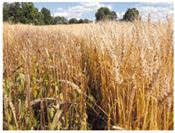Wheat Varietal Differences In Deer Browsing Damage

Image 1. The bearded variety on the right had 0% deer damage and the awnless variety on the left had 95%
of seedheads selectively eaten.
BILL BRUENING
LEXINGTON, KY.
In many regions of the United States, crop damage from deer browsing is a perennial problem. Deer are primarily associated with damage to soybean and corn, but are also known to damage wheat. According to the National Agricultural Statistics Service, deer cause $359 million in field crop damages in the U.S. annually. Wheat foliage provides a good source of high protein forage throughout winter and spring. Foliage browsing typically does not affect grain yield. Wheat seedheads are also eaten by deer from the soft-sough stage to maturity, which directly affects yield. Most browsing damage on grain crops occur near woodlot/ field edges.
Managing deer population numbers by state wildlife agencies is the primary way to limit deer damage to crops. Use of chemical retardants, taste retardants, fencing, and frightening devices may also discourage browsing, but wheat variety selection may be the simplest and most cost effective way to minimize potential yield losses by planting unpalatable bearded (awned) varieties. Alternatively, when selecting wheat varieties to enhance habitat for hunting, awnless headed varieties are recommended for deer plots. Wheat awns are unpalatable and consumption of mature awns has been shown to be detrimental to deer health.
Late season deer damage (head browsing) was recorded at the 2019 University of Kentucky Wheat Variety Trial in Crittenden County, KY. The trial was located approximately 50 meters from a forest edge and was surrounded with wheat planted by the cooperating grower. There were 84 wheat entries (59 bearded [awned], 23 awnless and 2 tip-awned [relatively smooth heads, with the exception of a whirl of awns attached near the tip of the head]) in the trial. The trial was set up in a randomized complete block design with four replicated plots per entry. Plots were 4 feet wide and 15 feet in length and planted under conventional tillage. Deer were observed in the variety trial and footprints indicated heavy deer traffic throughout the field. Deer damage ratings were recorded at maturity for each plot as the percentage of heads removed. The results were averaged across reps and summarized. The head browsing occurred late in the growing season and the damage percentage should be comparable to expected grain yield reductions.
Fifty-six of the 59 bearded entries had no deer damage. The average level of de-heading damage for all bearded varieties was 0.08 percent. Only 3 of the 59 bearded varieties showed deer damage, which was minimal (ranging from 1 to 3 percent). All 23 awnless varieties showed deer damage ranging from 5 to 88 percent and averaged 54 percent (Image 1). The two tip-awned varieties had 0 and 21 percent damage indicating some “poor” palatability protection. These results indicate that deer avoided browsing on bearded heads and caused considerable damage to the awnless varieties.
In conclusion, this data supports the recommendation that awnless wheat varieties be used for planting deer plots to enhance deer habitat and that bearded varieties should be used for grain production in areas with high deer populations. ∆
BILL BRUENING: Research Specialist, University of Kentucky